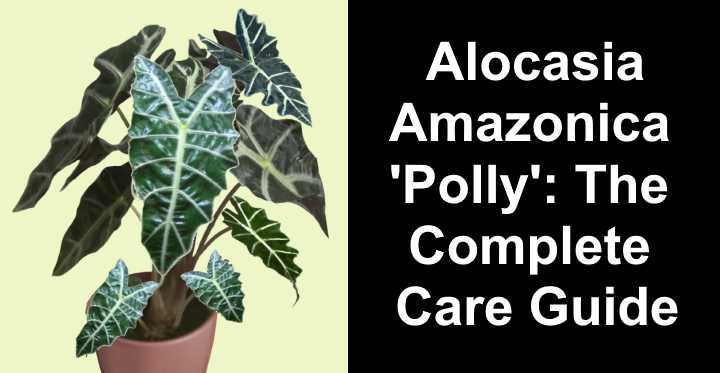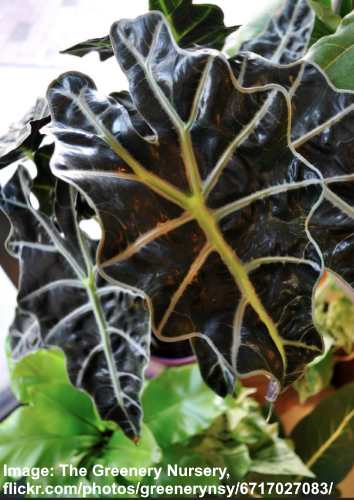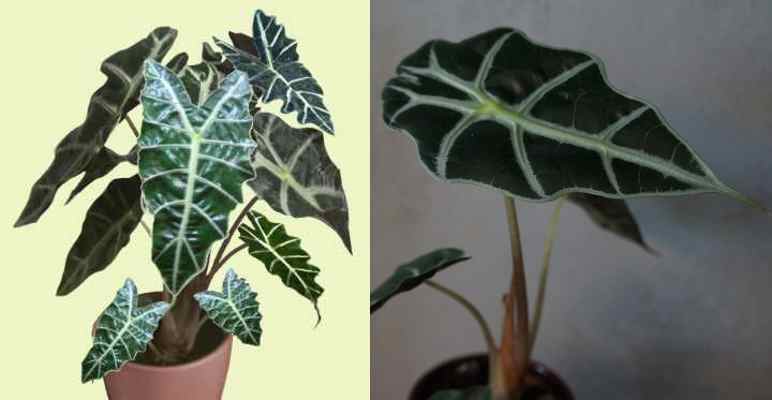Alocasia ‘Polly’ Care: How to Grow Alocasia Amazonica ‘Polly’ (African Mask Plant)

The Alocasia amazonica ‘Polly,’ or African Mask plant, is an evergreen tropical perennial houseplant with stunning dark green, arrow-shaped leaves and lobed, wavy edges. The striking feature of Alocasia ‘Polly’ is its glossy green leaves contrasting with their with creamy-white veins. Also called the Amazon Elephant Ear, Alocasia amazonica ‘Polly’ produces spathe flowers similar to calla lilies.
Alocasia ‘Polly’ houseplants have compact growth and are easy to grow indoors. The main characteristic of this unusual houseplant is the unique triangular leaves. Although African mask plant flowers, it rarely blooms indoors. However, most people grow African Mask plants for their fascinating foliage.
This article is a complete care guide for the Alocasia amazonica ‘Polly.’ At the end of the article, you’ll find helpful tips on making sure the eye-catching perennial houseplant thrives indoors.
How to Care for Alocasia Amazonica ‘Polly’
Alocasia ‘Polly’ grows best in bright indirect light in a loose, fertile potting mix with excellent drainage. Water the African Mask plant when the top 1” (2.5 cm) of soil is dry and mist the large leaves to increase humidity. Keep temperatures between 65°F and 80°F (18°C – 27°C) and fertilize every month during the growing season.
Alocasia Polly Plant Facts

Alocasia amazonica ‘Polly’ is also called the African Mask plant and Elephant Ears
Alocasia ‘Polly’ is a compact cultivar of the Alocasia amazonica tropical plant. It’s thought that Alocasia ‘Polly’ is a hybrid of two species—Alocasia watsoniana and Alocasia sanderiana. Despite the cultivar being called amazonica, it’s not known where this Alocasia hybrid originated.
Alocasia ‘Polly’ is prized for its spectacular glossy arrowhead leaves with large protruding silvery-green or white veins. ‘Polly’ plants grow up to 2 ft. (0.6 m) tall with a similar-sized spread.
The Alocasia ‘Polly’ has spreading rhizome roots that make the plant easy to propagate
Common names for the Alocasia amazonica ‘Polly’ include African Mask plant, Elephant Ears, and Kris plant. These names all refer to the characteristics of the triangular leaves. For example, the Alocasia leaves look like the shape of an elephant’s ears or a traditional African Mask. The name Kris plant is because it resembles the wavy blade of a kris or Kalis dagger.
African Mask Plant (Alocasia Amazonica) Flowers
Alocasia amazonica ‘Polly’ produces spathe flowers similar to peace lilies or calla lilies. The African Mask plant’s flowers have a flowering spadix that looks like a long spike. A spathe or colorful leaf-like bract surrounds this flowering spike. African Mask flowers are creamy-white to yellow, surrounded by a light green spathe.
Although Alocasia amazonica ‘Polly’ is a species of tropical flowering plant, they rarely flower indoors. However, the flowers are insignificant and are not as magnificent as the large arrowhead foliage the plant produces.
Alocasia Polly Growth Rate
Under ideal conditions, Alocasia plants are fast-growing evergreen perennial plants. Larger plants may grow one or two new leaves a month, whereas younger plants have a slower growth rate.
Like all species of Alocasia, the Alocasia ‘Polly’ has a dormant period. During this time, the leaves will fade and die. However, after this time, the plants become rejuvenated and start growing new leaves again.
Alocasia Amazonica’ Polly’ Care Guide
Let’s look in more detail at how to look after an African Mask plant (Alocasia amazonica ‘Polly’) at home.
Alocasia ‘Polly’ Light Needs

To care properly for your Alocasia ‘Polly’ plant, give it plenty of indirect sunlight
Alocasia amazonica ‘Polly’ needs plenty of bright indirect light to thrive indoors. It’s crucial to protect the ‘Polly’ plant from direct sunlight to prevent scorching the leaves. Also, avoid putting Alocasia ‘Polly’ plants in dark rooms or constant shade. The growth will slow, and you’ll lose the vibrant leaf colors.
The native habitat of Elephant’s Ears plants is in tropical forests beneath the tree canopy. Although Alocasia leaves seem leathery and robust, direct sunlight can burn the leaves and cause them to lose their color.
The best location to grow Alocasia ‘Polly’ plants is near a bright window. But if the window faces south or west, it’s best to protect the tropical plant behind a sheer curtain.
Although they grow on the forest floor, African Mask plants are not low-light plants. Insufficient light causes the foliage to lose its color, and the plant eventually dies. Even if there’s some light, the African Mask plant won’t grow well and suffer from leaf discoloration.
The Best Soil for African Mask Plant
The best soil for Alocasia amazonica ‘Polly’ is a well-draining, aerated potting mix. You can combine one part regular houseplant soil, one part peat moss, and one part perlite. This combination of soil ingredients creates a porous, fertile growing medium that holds some moisture but allows excess water to drain fast.
When caring for African Mask plants, the soil mix is one of the most critical factors. Peat moss helps replicate the decomposing organic matter on the forest floor. Amending the soil with perlite, coarse horticultural sand, bark shavings, or charcoal, helps boost drainage.
It’s good to remember that Alocasia ‘Polly’ plants like moist soil but can’t survive in soggy soil. So, the potting mix should be light enough that it partially dries between watering. Signs that the soil is too dense or heavy include the following:
- Water drains slowly through the soil.
- Water pools on the soil’s surface.
- The Alocasia ‘Polly’ shows signs of overwatering—drooping growth and yellowing leaves.
It’s best to lighten the potting soil by amending it with perlite or gravel in these cases.
How to Water Alocasia ‘Polly’
You should water an Alocasia ‘Polly’ plant often enough to keep the plant roots slightly moist. The best watering method is to water often with little amounts of water. Before watering, always ensure the top 1” (2.5 cm) of soil is dry before watering. The watering frequency depends on how fast the top layer of soil dries.
Letting the soil dry before watering ensures that you never overwater your houseplants. Watering too often causes the roots to rot, which will eventually kill the Alocasia plant. If you don’t water enough, the roots will not get enough moisture, and the plant will wilt.
Most houseplants thrive when you drench the soil between watering. However, with Alocasia plants, that could risk causing root rot. So, provide enough water to reach to the roots and only water when the soil partially dries.
Here are some handy tips on watering African Mask plants:
- Never water on a set schedule but check for soil dryness before watering.
- Water a little and frequently to ensure the soil is constantly moist.
- Only water Alocasia ‘Polly’ occasionally in winter because the plant growth becomes dormant.
- Avoid the tendency to water the plant when it becomes dormant. During dormancy, all you need to do is keep the soil moist.
Temperature Requirements to Grow Alocasia ‘Polly’ at Home
African Mask plants thrive in warm temperatures. Generally, average room temperatures between 65°F and 80°F (18°C – 27°C) are ideal for healthy growth. If the room temperature dips below 60°F (15°C), the plant can stop growing as it goes into dormancy. If the temperature is too low, the Alocasia ‘Polly’ will start shedding leaves.
When growing any species of Alocasia plant, it’s crucial to avoid temperature extremes. In winter, keep the Alocasia elephant’s ears plant in a warm room, but away from a hot radiator. Also, make sure that cold drafts from windows don’t affect the plant. In summer, ensure that the plant doesn’t stand in the air-conditioning flow.
When growing in warm, bright conditions, you can expect rapid growth from an Alocasia ‘Polly’ plant. You can also take the potted tropical houseplants outdoors during the warm summer months.
Alocasia amazonica grows outdoors in zones 10 through 12 and needs high humidity. If you grow a potted ‘Polly’ plant outside in summer, bring it inside when the temperature falls below 65°F (18°C).
Humidity Needs for Alocasia Polly Houseplants
Alocasia amazonica ‘Polly’ has high humidity requirements. Household air is generally too dry for African Mask plants, and the glossy leaves can become dry and crispy. Increase humidity by misting the leaves with filtered tap water at least twice a week. Warm, humid conditions indoors are perfect for fast, healthy Alocasia plant growth.
Here are some other handy tips for raising indoor humidity levels for growing Alocasia plants:
- Pebble tray—Put a layer of decorative pebbles in a deep tray and pour in water, so it’s half-way up the stones. Place your potted African Mask plant on the layer of pebbles. As the water evaporates, it will humidify your tropical plant.
- Humidifier—Use a room humidifier to increase humidity levels to at least 50 percent.
- Grow plants together—Place your houseplants together to create a humid environment and encourage healthy growth.
The Best Fertilizer for Growing African Mask Plants (Alocasia Amazonica)
African Mask plants need fertilizing during the growing season. Use a diluted, balanced houseplant fertilizer and feed the plant every two to four weeks. Fertilizing Alocasia ‘Polly’ plants from spring until the end of August encourages fast growth. Your Amazon “elephant’s ears” plants should produce a leaf every month in summer.
Fertilizing tropical houseplants can be tricky. Mineral salts can build up in the soil and cause root burn. Therefore, it’s a good idea to dilute a liquid fertilizer to half strength. Or you can use slow-release fertilizer that lasts for several months.
In most cases, it’s best to use a natural houseplant fertilizer. Organic fertilizers contain all the minerals and nutrients fast-growing plants need. Also, they are not as harsh as chemical fertilizers, and you can avoid nutrient burn.
Repotting Elephant Ear Plants (Alocasia Amazonica)
You may need to repot a healthy Alocasia amazonica ‘Polly’ plant every year. The best time to transfer an Amazon Elephant Ear plant is in spring when growth is vigorous. Repotting also lets you refresh the potting soil and check the rhizome roots for any signs of damage.
When repotting an Alocasia ‘Polly’ plant, always choose a container one size up. This allows the roots more room to grow. It would be best if you also repotted the plants using a fresh potting mix.
To repot an Alocasia plant, remove the plant from its container. Remove all excess dirt from the roots. Half-fill a new pot with an appropriate potting mix. Place the roots in the pot so that the Alocasia amazonica plant is growing at the same height as before. Fill the remaining space with soil and water thoroughly.
Pruning Alocasia ‘Polly’ Houseplants
The only reason to prune African Mask plants is to remove dead or damaged leaves. All you need to do is snip off the old leaf with clean pruning shears near the stem’s base. Because Alocasia amazonica plants are fast growers, pruning does not affect plant growth.
Propagating Alocasia Amazonica ‘Polly’
The best way to propagate Alocasia ‘Polly’ plants is by root division. The rhizome roots grow offsets that you can separate from the mother plant and replant in a new pot. For best results, propagate ‘Polly’ plants in spring.
To propagate Alocasia ‘Polly’ remove the plant from its container and remove soil from the roots. Look for offsets at the base of the plant and gently separate them. Replant the Alocasia offsets in fresh potting soil and keep in a warm, humid environment until the roots appear. Then, care for the plant as usual.
Pests that Affect Alocasia ‘Polly’ Plants
Spider mites can often affect potted Alocasia ‘Polly’ plants. Use a neem oil solution to get rid of the tiny houseplant pests. Mix 2 tsp. neem oil and 1 tsp. liquid dish soap with a quart (1 l) of lukewarm water in a spray bottle. Liberally spray both sides of the foliage with the natural bug solution to kill spider mites.
Spider mites are a type of destructive plant pest that are hard to spot, but they can weaken your plant’s growth if you don’t get rid of them. Spider mites can also quickly infest other houseplants.
Disease Problems with African Mask Plants
Root rot can affect African Mask plant growth. However, root rot is avoidable if you always water Alocasia plants correctly. Overly wet soil causes roots to decay and rot. This eventually causes irreparable damage to the plant’s roots.
The signs of root rot on Alocasia ‘Polly’ plants are black patches that appear at the base of the plant’s roots and foliage. By this time, it’s usually not possible to save a dying Alocasia plant.
Here are a few tips to avoid root rot on Alocasia and other tropical houseplants:
- Ensure the soil is always loose and aerated and drains well.
- Only water houseplants as often enough as the top layer of soil dries.
- Avoid watering plants too frequently when they are in a dormant period.
Are Alocasia ‘Polly’ Plants Toxic?
Alocasia amazonica ‘Polly’ is poisonous for cats and dogs. The ASPCA says that “Elephant’s Ear” plants can cause oral irritation and pain if dogs or cats ingest any of the plant matter. Other signs of Alocasia ‘Polly’ poisoning are drooling, vomiting, and difficulty swallowing.
African Mask plants are also toxic to humans. Ingesting the leaves can cause burning or blistering in the mouth and throat, pain when swallowing, nausea, vomiting and diarrhea.
FAQs About Alocasia ‘Polly’ Care
Although Alocasia amazonica plants are generally easy to care for, you should be aware of a few issues.
My Alocasia ‘Polly’ seems to be dying, what should I do?
It may seem that your Alocasia ‘Polly’ plant is dying if it’s in a period of dormancy. Cold weather or dry soil causes the plant to stop growing for a while. During this time, leaves can turn brown and fall off. However, the plant should come back to life in the spring.
However, other growing conditions can affect your plant’s growth. For example, soggy soil can cause root rot and kill your plant. Or if the ‘Polly’ plant has been in the dark for too long, it can start to die.
What are brown spots on African mask plant leaves?
A lack of humidity often makes brown spots appear on Alocasia ‘Polly’ plant leaves. So, it’s crucial to increase humidity by misting the Alocasia plant’s leaves daily and making sure it gets enough—but not too much—water.
Why Alocasia Amazonica leaves turning yellow?
Watering issues are usually the root cause of yellowing leaves. Either too much water and overly damp soil or dry potting mix can cause leaves to turn yellow. Another reason for yellow Alocasia plant leaves is too much sunlight.
How long does Alocasia ‘Polly’ dormancy last for?
Alocasia amazonica ‘Polly’ goes into dormancy during the winter. From late fall until spring, growth stops, and the foliage may die off. You should keep the soil moist during this time but hold off from watering or fertilizing the plant. The Alocasia ‘Polly’ plant should start growing again in spring.
Related articles:
